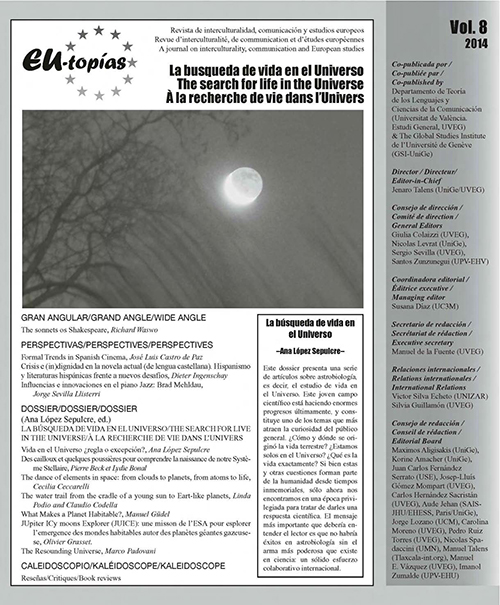What Makes a Planet Habitable?
DOI:
https://doi.org/10.7203/eutopias.0.18778Parole chiave:
Exoplanetas, habitabilidad, vida Abstract
Abstract
Antes de que la vida pueda surgir y desarrollarse en una superficie planetaria, son necesarias muchas condiciones de naturaleza astrofísica. La radiación y las partículas provenientes de la estrella central, el campo magnético del planeta, la acumulación o disipación de la atmósfera en un planeta joven, y varios otros factores deben actuar conjuntamente y de manera equilibrada para dar a la vida la oportunidad de florecer. En este artículo describimos estos prerrequisitos cruciales para la habitabilidad y exponemos el estado actual de nuestro conocimiento.
 Downloads
Downloads
 Riferimenti bibliografici
Riferimenti bibliografici
Feulner , Georg (2012) “The faint young Sun problem”, Reviews of Geophysics, 50, CiteID RG2006.
Elkins-Tanton , Linda T. (2008) “Linked magma ocean solidification and atmospheric growth for Earth and Mars”, Earth Planet. Sci. Lett., 271, pp. 181-191.
Grenfell , John L., et al. (2014) “Sensitivity of biosignatures on Earth-like planets orbiting in the habitable zone of cool M-dwarf stars to varying stellar UV radiation and surface biomass emissions”, Planet. Space Sci., 98, pp. 66-76.
Güdel , Manuel, et al. (2014) “Astrophysical Conditions for Planetary Habitability”. In Protostars and Planets VI, in press.
Kasting, James F. (1988) “Runaway and moist greenhouse atmospheres and the evolution of earth and Venus”, Icarus, 74, pp. 472-494.
Kasting, James F.; Whitmire , Daniel P.; Rey – nolds , Ray T. (1993) ”Habitable Zones around Main Sequence Stars”, Icarus, 101, pp. 108-128.
Kasting, James F.; Catling , D. (2003) “Evolution of a Habitable Planet”, Annu. Rev. Astron. Astrophys., 41, pp. 429-463.
Khodachenko , Maxim L., et al. (2012) “Magnetospheres of “Hot Jupiters”, Astrophys. J., 744, pp. 70-86.
Kislyakova , Kristina G., et al. (2013) “XUV-Exposed, Non-Hydrostatic Hydrogen-Rich Upper Atmospheres of Terrestrial Planets. Part II: Hydrogen Coronae and Ion Escape”, Astrobiol., 13, pp. 1030-1048.
Lammer , Helmut, et al. (2013) “Outgassing History and Escape of the Martian Atmosphere and Water Inventory”, Space Sci. Rev., 174, pp. 113-154.
Lammer , Helmut, et al. (2014) “Origin and loss of nebula- captured hydrogen envelopes from `sub’- to `super- Earths’ in the habitable zone of Sun-like stars”, Mon. Not. Roy. Astron. Soc., 439, pp. 3225-3238.
Lang, Kenneth (1999) Astrophysical Formulae, New York: Springer.
Mayor , Michel; Queloz , Didier (1995) “A Jupitermass companion to a solar-type star”, Nature, 378, pp. 355-359.
Ribas , Ignasi; Guinan, Edward F.; Güdel , Manuel; Audard , Marc (1995) “Evolution of the Solar Activity over Time and Effects on Planetary Atmospheres”, Astrophys. J., 622, pp. 680-694.
Rondanelli , Roberto; Lindzen , Richard S. (2010) “Can thin cirrus clouds in the tropics provide a solution to the faint young Sun paradox?” J. Geophys. Res., 115, D02108.
Sackmann, I.-Juliana; Boothroyd , Arnold I. (2003) “Our Sun. V. A Bright Young Sun Consistent with Helioseismology and Warm Temperatures on Ancient Earth and Mars”, Astrophys. J., 583, pp. 1024- 1039.
Wagner , Frank W. (2011) “Interior structure models of solid exoplanets using material laws in the infinite pressure limit”, Icarus 214, pp. 366-376.
Wood , Brian E. (2004) “Astrospheres and Solar-like Stellar Winds”, Liv. Rev. Solar Phys., 1, no 2.
Downloads
Pubblicato
Come citare
-
Abstract181
-
PDF 66
Fascicolo
Sezione
Licenza
![]()
Tutti i contenuti pubblicati in EU-topías. Rivista di interculturalità, communicazione e studi europei è concesso in licenza Creative Commons Attribution-NonCommercial-ShareAlike 4.0. Il testo completo della licenza è disponibile all’indirizzo http://creativecommons.org/licenses/by-nc-sa/4.0
Essi possono essere copiati, utilizzati, diffusi, trasmessi e visualizzati pubblicamente, a condizione che ciò avvenga:
- Viene citata la paternità e la fonte originale della pubblicazione (rivista, editore e URL dell’opera).
- Non vengono utilizzati per scopi commerciali.
- L’esistenza e le specifiche di questa licenza d’uso sono menzionate.



